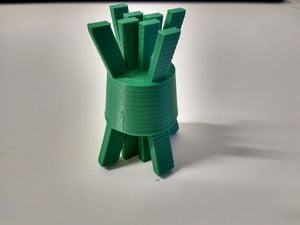
Designer
Sabin Karki' Aalto University, Department of Electronics and Nanoengineering
Project
Planar Rotman lens is a beamforming network commonly used in high frequency. The design equation of planar Rotman lens can be be easily found in literatures. The lens allows multiple antenna beam to be formed. However, the planar nature of the Rotman Lens limits beam steering in one plane. Basic idea of this project is to design 3D Rotman lens with 3D printing technology that is capable of steering antenna beams in both planes.
Model
The 3D Rotman lens consist of three parts: feed ports, lens body and the receiving port.
The planar Rotman lens structure is designed using the design equations from literatures. The design equation gives the shape of the lens body and the position of the feeding and receiving ports, and the length of the receiving port. 3D lens body is generated by rotating the lens curve around the axis. Then the feed and receiving feed lines are designed based on the operating frequency and lens body. Thus, generated feed and receiving ports are positioned on correct points on the lens surface.
The scad file is well parameterized for frequency, alpha, beta .. etc. except number of feed and receiving ports.
Currently, the PLA material have dielectric constant of 3. Due to low dielectric constant the feed structure itself is radiating. Therefore, printing material of high dielectric constant is desired. Metallization of the feed and receiving port can also solve the problem.
Planned upgrades
In the design, the receiving antennas are placed based on the planar design principle. Additional, receiving ports needs to be added to make the structure more effective. However, the structure is ready for measurement and simulation purpose.
Bill of Materials
Manufacturing cost of 3D Rotman lens is determined by its size. And size is dependent on the material used and operation frequency.
Weight of the 3D Rotman Lens printed with PLA material at various frequencies are:
10 GHz = 45 gram = 1.125 € (PLA price 25€/kg)
30 GHz = 2 gram = 0.05 €(PLA price 25€/kg)
50 GHz = 1 gram = 0.025 € (PLA price 25€/kg)
Additional metallization cost might be required for operation.
Estimated Cost
N/A since similar products are not commercially available.
Directions
Good understanding of Rotman Lens is preferred for efficient design.
1. Download the OPENscad files from [1] .
2. Parameters can be changed according to requirement.
3. Print 3D Rotman Lens.
Final Prints
10 GHz and 50 GHz lens were printed using Lulzbot mini whereas 30 GHz prototype was printed using Formlabs SLA printer. The print speed was set to 50 mm/s, and a layer height of 0.25 mm was used. For 50 GHz prototype, the surface roughness is high therefore SLA printer is recommended at high frequency.
External links
- []
[[Category:]] [[Category:]]












